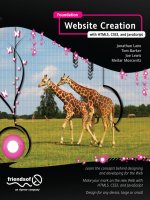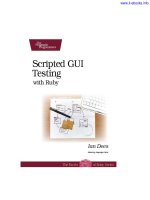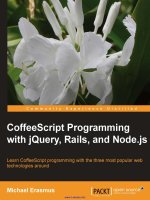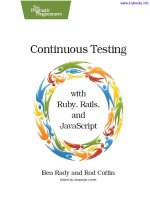Continuous Testing with Ruby, Rails, and JavaScript potx
Bạn đang xem bản rút gọn của tài liệu. Xem và tải ngay bản đầy đủ của tài liệu tại đây (5.23 MB, 162 trang )
www.it-ebooks.info
Continuous Testing
with Ruby, Rails, and JavaScript
Ben Rady
Rod Coffin
The Pragmatic Bookshelf
Dallas, Texas • Raleigh, North Carolina
www.it-ebooks.info
Many of the designations used by manufacturers and sellers to distinguish their products
are claimed as trademarks. Where those designations appear in this book, and The Pragmatic
Programmers, LLC was aware of a trademark claim, the designations have been printed in
initial capital letters or in all capitals. The Pragmatic Starter Kit, The Pragmatic Programmer,
Pragmatic Programming, Pragmatic Bookshelf, PragProg and the linking g device are trade-
marks of The Pragmatic Programmers, LLC.
Every precaution was taken in the preparation of this book. However, the publisher assumes
no responsibility for errors or omissions, or for damages that may result from the use of
information (including program listings) contained herein.
Our Pragmatic courses, workshops, and other products can help you and your team create
better software and have more fun. For more information, as well as the latest Pragmatic
titles, please visit us at .
The team that produced this book includes:
Jacquelyn Carter (editor)
Potomac Indexing, LLC (indexer)
Kim Wimpsett (copyeditor)
David J Kelly (typesetter)
Janet Furlow (producer)
Juliet Benda (rights)
Ellie Callaghan (support)
Copyright © 2011 Pragmatic Programmers, LLC.
All rights reserved.
No part of this publication may be reproduced, stored in a retrieval system, or
tra ns mi tted, in a ny form , or by any me an s, elec troni c, mech an ical, phot oc op yi ng,
recording, or otherwise, without the prior consent of the publisher.
Printed in the United States of America.
ISBN-13: 978-1-934356-70-8
Printed on acid-free paper.
Book version: P1.0—June 2011
www.it-ebooks.info
Contents
Acknowledgments . . . . . . . . . . vii
Preface . . . . . . . . . . . . . ix
2.1 Exploring the Chapters x
2.2 Who This Book Is For xi
2.3 Working the Examples xii
2.4 Online Resources xii
1. Why Test Continuously? . . . . . . . . . 1
1.1 What Is Continuous Testing? 2
1.2 Beyond Automated Tests 2
1.3 Enhancing Test Driven Development 4
1.4 Continuous Testing and Continuous Integration 4
1.5 Learning to Test Continuously 6
Part I — Ruby and Autotest
2. Creating Your Environment . . . . . . . . 11
2.1 Getting Started with Autotest 11
2.2 Creating a Potent Test Suite with FIRE 16
2.3 Writing Informative Tests 17
2.4 Writing Fast Tests 23
2.5 Writing Reliable Tests 27
2.6 Creating an Exhaustive Suite 33
2.7 Closing the Loop 35
3. Extending Your Environment . . . . . . . . 37
3.1 Using Autotest Plugins 37
3.2 Adding Event Hooks 40
3.3 Creating Plugins 45
3.4 Closing the Loop 52
www.it-ebooks.info
4. Interacting with Your Code . . . . . . . . 53
4.1 Understanding Code by Changing It 53
4.2 Comparing Execution Paths 58
4.3 Learning APIs Interactively 61
4.4 Making It till You Fake It 68
4.5 Closing the Loop 75
Part II — Rails, JavaScript, and Watchr
5. Testing Rails Apps Continuously . . . . . . . 79
5.1 Building Our Rails App 80
5.2 Creating a CT Environment with Watchr 80
5.3 Validating Style Sheets 82
5.4 Migrating Continuously 84
5.5 Running Rails Specs Fast 86
5.6 Closing the Loop 90
6. Creating a JavaScript CT Environment . . . . . 91
6.1 Using Node.js 92
6.2 Checking Syntax with JSLint 93
6.3 Writing FIREy Tests with Jasmine 94
6.4 Running Tests Using Node.js and Watchr 97
6.5 Closing the Loop 100
7. Writing Effective JavaScript Tests . . . . . . 103
7.1 Mocking Out the Browser 103
7.2 Testing Asynchronous View Behavior 107
7.3 Testing View Aesthetics 112
7.4 Closing the Loop 115
Part III — Appendices
A1. Making the Case for Functional JavaScript . . . . 119
A 1 . 1 Is JavaScript Object Oriented or Functional? 119
A 1 . 2 Introducing Modit 122
A 1 . 3 Functional Programming in JavaScript 127
A2. Gem Listing . . . . . . . . . . . . 133
A3. Bibliography . . . . . . . . . . . . 135
www.it-ebooks.info
www.it-ebooks.info
Acknowledgments
We would like to thank everyone who offered encouragement and advice
a l o n g the way , i ncl ud in g o ur r evi e wer s: P a ul H ols er , N oel R a ppi n, B i ll C apu t o,
Fred Daoud, Craig Riecke, Slobodan (Dan) Djurdjevic, Ryan Davis, Tong
Wang, and Jeff Sacks. Thanks to everyone at Improving Enterprises and
the development team at Semantra for contributing to our research and
helping us test our ideas. We’d like to thank Dave Thomas and Andy Hunt
for giving us the opportunity to realize our vision for this book. Thanks also
to our editor, Jackie Carter, for slogging alongside us week by week to help
make that vision a reality.
We’d also like to thank all the Beta readers who offered feedback, including
Alex Smith, Dennis Schoenmakers, “Johnneylee” Jack Rollins, Joe Fiorini,
Katrina Owen, Masanori Kado, Michelle Pace, Olivier Amblet, Steve Nichol-
son, and Toby Joiner.
From Ben
I would like to thank my wife, Jenny, for supporting all of my crazy endeavors
over the last few years, including this book. They’ve brought us joy and
pain, but you’ve been by my side through it all. I’d also like to thank my
mom, who first taught me the value of the written word and inspired me to
use it to express myself.
From Rod
I would like to thank my wife for her encouragement and many sacrifices,
my brother for his friendship, my mom for her unconditional love, and my
dad for showing me how to be a husband, father, and citizen.
report erratum • discuss
www.it-ebooks.info
We've left this page blank to
make the page numbers the
same in the electronic and
paper books.
We tried just leaving it out,
but then people wrote us to
ask about the missing pages.
Anyway, Eddy the Gerbil
wanted to say “hello.”
www.it-ebooks.info
Preface
As professional programmers, few things instill more despair in us than
discovering a horrible production bug in something that worked perfectly
fine last week. The only thing worse is when our customers discover it and
inform us…angrily. Automated testing, and particularly test driven develop-
ment, were the first steps that we took to try to eliminate this problem. Over
the last ten years, these practices have served us well and helped us in our
fight against defects. They’ve also opened the doors to a number of other
techniques, some of which may be even more valuable. Practices such as
evolutionary design and refactoring have helped us deliver more valuable
software faster and with higher quality.
Despite the improvements, automated testing was not (and is not) a silver
bullet. In many ways, it didn’t eliminate the problems we were trying to ex-
terminate but simply moved them somewhere else. We found most of our
errors occurring while running regression or acceptance tests in QA environ-
ments or during lengthy continuous integration builds. While these failures
were better than finding production bugs, they were still frustrating because
they meant we had wasted our time creating something that demonstrably
did not work correctly.
We quickly realized that the problem in both cases was the timeliness of
the feedback we were getting. Bugs that happen in production can occur
weeks (or months or years!) after the bug is introduced, when the reason
for the change is just a faint memory. The programmer who caused it may
no longer even be on the project. Failing tests that ran on a build server or
in a QA environment told us about our mistakes long after we’d lost the
problem context and the ability to quickly fix them. Even the time between
writing a test and running it as part of a local build was enough for us to
lose context and make fixing bugs harder. Only by shrinking the gap between
the creation of a bug and its resolution could we preserve this context and
turn fixing a bug into something that is quick and easy.
report erratum • discuss
www.it-ebooks.info
While looking for ways to shrink those feedback gaps, we discovered contin-
uous testing a n d started applying i t in o u r work. T h e results were compelling.
Continuous testing has helped us to eliminate defects sooner and given us
the confidence to deliver software at a faster rate. We wrote this book to
share these results with everyone else who has felt that pain. If you’ve ever
felt fear in your heart while releasing new software into production, disap-
pointment while reading the email that informs you of yet another failing
acceptance test, or the joy that comes from writing software and having it
work perfectly the first time, this book is for you.
Using continuous testing, we can immediately detect problems in
code—before it’s too late and before problems spread. It isn’t magic but a
clever combination of tests, tools, and techniques that tells us right away
when there’s a problem, not minutes, hours, or days from now but right
now, when it’s easiest to fix. This means we spend more of our time writing
valuable software and less time slogging through code line by line and sec-
ond-guessing our decisions.
Exploring the Chapters
This book is divided into two parts. The first part covers working in a pure
Ruby environment, while the second discusses the application of continuous
testing in a Rails environment. A good portion of the second part is devoted
to continuous testing with JavaScript, a topic we believe deserves particular
attention.
In Chapter 1, Why Test Continuously?, on page 1, we give you a bit of
context. This chapter is particularly beneficial for those who don’t have
much experience writing automated tests. It also establishes some terminol-
ogy we’ll use throughout the book.
The next three chapters, Chapter 2, Creating Your Environment, on page 11,
Chapter 3, Extending Your Environment, on page 37, and Chapter 4, Inter-
acting with Your Code, on page 53, show how to create, enhance, and use
a continuous testing environment for a typical Ruby project. We’ll discuss
the qualities of an effective suite of tests and show how continuous testing
helps increase the quality of our tests. We’ll take a close look at a continuous
test runner, Autotest, and see how it can be extended to provide additional
behavior that is specific to our project and its needs. Finally, we’ll discuss
some of the more advanced techniques that continuous testing allows, in-
cluding inline assertions and comparison of parallel execution paths.
report erratum • discuss
• x
www.it-ebooks.info
In the second part of the book, we create a CT environment for a Rails app.
In addition to addressing some of the unique problems that Rails brings
into the picture, we also take a look at another continuous test runner,
Watchr. As we’ll see, Watchr isn’t so much a CT runner but a tool for easily
creating feedback loops in our project. We’ll use Watchr to create a CT envi-
ronment for JavaScript, which will allow us to write tests for our Rails views
that run very quickly and without a browser.
At the very end, we’ve also included a little “bonus” chapter: an appendix
on using JavaScript like a functional programming language. If your use of
JavaScript has been limited to simple HTML manipulations and you’ve
never had the opportunity to use it for more substantial programming, you
might find this chapter very enlightening.
For the most part, we suggest that you read this book sequentially. If you’re
very familiar with automated testing and TDD, you can probably skim
through the first chapter, but most of the ideas in this book build on each
other. In particular, even if you’re familiar with Autotest, pay attention to
the sections in Chapter 2, Creating Your Environment, on page 11 that dis-
cuss FIRE and the qualities of good test suites. These ideas will be essential
as you read the later chapters.
Each chapter ends with a section entitled “Closing the Loop.” In this section
we offer a brief summary of the chapter and suggest some additional tasks
or exercises you could undertake to increase your understanding of the
topics presented in the chapter.
Terminology
We use the terms test and spec interchangeably throughout the book. In
both cases, we’re referring to a file that contains individual examples and
assertions, regardless of the framework we happen to be working in.
We frequently use the term production code to refer to the code that is being
tested by our specs. This is the code that will be running in production after
we deploy. Some people call this the “code under test.”
Who This Book Is For
Hopefully, testing your code continuously sounds like an attractive idea at
this point. But you might be wondering if this book is really applicable to
you and the kind of projects you work on. The good news is that the ideas
we’ll present are applicable across a wide range of languages, platforms,
report erratum • discuss
• xi
www.it-ebooks.info
and projects. However, we do have a few expectations of you, dear reader.
We’re assuming the following things:
• You are comfortable reading and writing code.
• You have at least a cursory understanding of the benefits of automated
testing.
• You can build tools for your own use.
Knowledge of Ruby, while very beneficial, isn’t strictly required. If you’re at
all familiar with any object-oriented language, the Ruby examples will likely
be readable enough that you will understand most of them. So if all of that
sounds like you, we think you’ll get quite a bit out of reading this book.
We’re hoping to challenge you, make you think, and question your habits.
Working the Examples
It’s not strictly necessary to work through the examples in this book. Much
of what we do with the examples is meant to spark ideas about what you
should be doing in your own work rather than to provide written examples
for you to copy. Nonetheless, working through some of the examples may
increase your understanding, and if something we’ve done in the book would
apply to a project that you’re working on, certainly copying it verbatim may
be the way to go.
To run the examples in this book, we suggest you use the following:
• A *nix operating system (Linux or MacOS, for example)
• Ruby 1.9.2
• Rails 3.0.4
In addition, you can find a list of the gems we used while running the exam-
ples in Appendix 2, Gem Listing, on page 133.
The examples may work in other environments (such as Windows) and with
other versions of these tools, but this is the configuration that we used while
writing the book.
Online Resources
The source for the examples is available at />tr/source_code.
If you’re having trouble installing Ruby, we suggest you try using the Ruby
Version Manager (or RVM), available at: />report erratum • discuss
• xii
www.it-ebooks.info
If something isn’t working or you have a question about the book, please
let us know in the forums at />Ben blogs at , and you can find his Twitter stream at
/>Ben Rady
June 2011
Rod Coffin
June 2011
report erratum • discuss
• xiii
www.it-ebooks.info
We've left this page blank to
make the page numbers the
same in the electronic and
paper books.
We tried just leaving it out,
but then people wrote us to
ask about the missing pages.
Anyway, Eddy the Gerbil
wanted to say “hello.”
www.it-ebooks.info
CHAPTER
1
Why Test Continuously?
Open your favorite editor or IDE. Take whatever key you have bound to Save
and rebind it to Save and Run All Tests. Congratulations, you’re now testing
continuously.
If you create software for a living, the first thing that probably jumped into
your head is, “That won’t work.” We’ll address that issue later, but just for
a moment, forget everything you know about software development as it is,
pretend that it does work, and join us as we dream how things could be.
Imagine an expert, with knowledge of both the domain and the design of
the system, pairing with you while you work. She tells you kindly, clearly,
and concisely whenever you make a mistake. “I’m sorry,” she says, “but you
can’t use a single string there. Our third-party payment system expects the
credit card number as a comma-separated list of strings.” She gives you
this feedback constantly—every time you make any change to the
code—reaffirming your successes and saving you from your mistakes.
Every project gets this kind of feedback eventually. Unfortunately for most
projects, the time between when a mistake is made and when it is discovered
is measured in days, weeks, or sometimes months. All too often, production
p r ob l em s lea d t o h ea t ed co n ve r sa ti on s t h at fi n al l y g iv e dev el o pe r s t he in s ig h t s
they wish they had weeks ago.
We believe in the value of rapid feedback loops. We take great care to discov-
er, create, and maintain them on every project. Our goal is to reduce the
length of that feedback loop to the point that it can be easily measured in
milliseconds.
report erratum • discuss
www.it-ebooks.info
1.1 What Is Continuous Testing?
To accomplish this goal, we use a combination of tools and techniques we
collectively refer to as continuous testing, or simply CT. A continuous testing
environment validates decisions as soon as we make them. In this environ-
ment, every action has an opposite, automatic, and instantaneous reaction
that tells us if what we just did was a bad idea. This means that making
certain mistakes becomes impossible and making others is more difficult.
The majority of the bugs that we introduce into our code have a very short
lifespan. They never make their way into source control. They never break
the build. They never sneak out into the production environment. Nobody
ever sees them but us.
A CT environment is made up of a combination of many things, ranging
from tools such as Autotest and Watchr to techniques such as behavior
driven development. The tools constantly watch for changes to our code and
run tests accordingly, and the techniques help us create informative tests.
The exact composition of this environment will change depending on the
language you’re working in, the project you’re working on, or the team you’re
working with. It cannot be created for you. You must build this environment
as you build your system because it will be different for every project, every
team, and every developer. The extent to which you’re able to apply these
principles will differ as well, but in all cases, the goal remains the same:
instant and automatic validation of every decision we make.
1.2 Beyond Automated Tests
The primary tools we use to create environments for continuous testing are
automated tests written by programmers as they write the production code.
Many software development teams have recognized the design and quality
benefits of creating automated test suites. As a result, the practice of auto-
mated testing—in one form or another—is becoming commonplace. In many
cases, programmers are expected to be able to do it and do it well as part
of their everyday work. Testing has moved from a separate activity performed
by specialists to one that the entire team participates in. In our opinion,
this is a very good thing.
Types of Tests
We strongly believe in automated testing and have used it with great success
over many years. Over that time we’ve added a number of different types of
automated tests to our arsenal. The first and most important of these is a
unit test. The overwhelming majority (let’s say 99.9%) of the tests we write
report erratum • discuss
What Is Continuous Testing? • 2
www.it-ebooks.info
are unit tests. These tests check very small bits of behavior, rarely larger
than a single method or function. Often we’ll have more than one individual
test for a given method, even though the methods are not larger than half
a dozen lines.
We don’t like to run through complete use cases in a single unit test—invok-
ing methods, making assertions, invoking more methods, and making more
assertions. We find that tests that do that are generally brittle, and bugs in
one part of the code can mask other bugs from being detected. This can re-
sult in us wasting time by introducing one bug while trying to fix another.
We favor breaking these individual steps into individual tests. We’ll take a
closer look at the qualities of good tests in Section 2.2, Creating a Potent
Test Suite with FIRE, on page 16.
Finding ourselves wanting to walk through a use case or other scenario in
a unit test is a sign that we might need to create an acceptance test. Tools
like Cucumber can be very useful for making these kinds of tests. While it’s
beyond the scope of this book, we would like to encourage you to check out
Cucumber, and especially its use within the larger context of behavior
driven development, at o/.
In addition to unit test and acceptance tests, we also employ other types of
tests to ensure our systems work as expected. UI tests can check the behav-
ior of GUI controls in various browsers and operating systems. Integration
tests, for example, can be used when the components in our system wouldn’t
normally fail fast when wired together improperly. System tests can be used
to verify that we can successfully deploy and start the system. Performance
and load tests can tell us when we need to spend some time optimizing.
Using Automated Tests Wisely
As we mentioned earlier in the chapter, unit tests are our first and largest
line of defense. We generally keep the number of higher level tests (system,
integration, etc.) fairly small. We never verify business logic using higher
level tests—that generally makes them too slow and brittle to be useful. This
is especially true of UI tests, where testing business logic together with UI
control behavior can lead to a maddening mess of interdependent failures.
Decoupling the UI from the underlying system so the business logic can be
mocked out for testing purposes is an essential part of this strategy.
The primary purpose of all of these tests is feedback, and the value of the
tests is directly related to both the quality and timeliness of that feedback.
We always run our unit tests continuously. Other types of tests are generally
report erratum • discuss
Beyond Automated Tests • 3
www.it-ebooks.info
run on a need-to-know basis—that is, we run them when we need to know
if they pass, but we can run any or all of these types of tests continuously
if we design them to be run that way.
We don’t have a lot of patience for tests that take too long to run, fail (or
pass) unexpectedly, or generate obscure error messages when they fail.
These tests are an investment, and like all investments, they must be chosen
carefully. As we’ll see, not only is continuous testing a way to get more out
of the investment that we make in automated testing, but it’s also a way to
ensure the investments we make continue to provide good returns over time.
1.3 Enhancing Test Driven Development
If you’re an experienced practitioner of test driven development, you may
actually be very close to being able to test continuously. With TDD, we work
by writing a very small test, followed by a minimal amount of production
code. We then refactor to eliminate duplication and improve the design.
With continuous testing, we get instant feedback at each of these steps, not
just from the one test we happen to be writing but from all the relevant tests
and with no extra effort or thinking on our part. This allows us to stay fo-
cused on the problem and the design of our code, rather than be distracted
by having to run tests.
Both TDD and CT come from a desire for rapid feedback. In many ways, the
qualities of a good continuous test suite are just the natural result of effec-
tively applying test driven development. The difference is that while using
continuous testing, you gain additional feedback loops. An old axiom of test
driven development states that the tests test the correctness of the code,
while the code, in turn, tests the correctness of the tests. The tests also test
the design of the code—code that’s poorly designed is usually hard to test.
But what tests the design of the tests?
In our experience, continuous testing is an effective way to test the design
and overall quality of our tests. As we’ll see in Chapter 2, Creating Your
Environment, on page 11, running our tests all the time creates a feedback
loop that tells us when tests are misbehaving as we create them. This means
we can correct existing problems faster and prevent bad tests from creeping
into our system in the first place.
1.4 Continuous Testing and Continuous Integration
You might be familiar with the practice of continuous integration (CI) and
wonder how it fits with continuous testing. We view them as complementary
practices. Continuous testing is our first line of defense. Failure is extremely
report erratum • discuss
Enhancing Test Driven Development • 4
www.it-ebooks.info
Feedback Loops: Trading Time for Confidence
90.000%
92.500%
95.000%
97.500%
100.000%
CT alone with CI with system test with exploratory test
0
15
30
45
60
Total Confidence Total Time
Confidence
Time
Figure 1—Trading time for confidence
cheap here, so this is where we want things to break most frequently.
Running a full local build can take a minute or two, and we want our CT
environment to give us the confidence we need to check in most of the time.
Sometimes, we have particular doubts about a change we’ve made. Perhaps
we’ve been mucking around in some configuration files or changing system
seed data. In this case we might run a full build to be confident that things
will work before we check in. Most of the time, however, we want to feel
comfortable checking in whenever our tests pass in CT. If we don’t have
that confidence, it’s time to write more tests.
Confidence, however, is not certainty. Continuous integration is there to
catch problems, not just spend a lot of CPU time running tests that always
pass. Sure, it helps us catch environmental problems, too (forgetting to
check in a file, usually). But it can also serve as a way to offload the cost of
running slower tests that rarely, but occasionally, fail. We don’t check in
code that we’re not confident in, but at the same time, we’re human and we
sometimes make mistakes.
Every project and team can (and should) have a shared definition of what
“confident” means. One way to think about it is as a series of feedback loops,
all having an associated confidence and time cost. Take a look at Figure 1,
Trading time for confidence, on page 5. This figure compares the confidence
generated by the feedback loops in our project to their relative cost. As we
move through our development process (left to right), total confidence in
our code increases logarithmically, while the total cost to verify it increases
exponentially.
report erratum • discuss
Continuous Testing and Continuous Integration • 5
www.it-ebooks.info
You Broke the Build!
We’ve worked with a few teams that seemed to fear breaking the build. It’s like they
saw a continuous integration build as a test of programming prowess. Breaking it
was a mortal sin, something to be avoided at all costs. Some teams even had little
hazing rituals they would employ when the build broke, punishing the offender for
carelessly defiling the code.
We think that attitude is a little silly. If the build never breaks, why even bother to
have it? We think there is an optimal build success ratio for each project (ours
usually runs around 90%+). We like being able to offload rarely failing tests to a CI
server, and if that means we need to fix something one of every ten or twenty builds,
so be it.
The important thing with broken builds is not that you try to avoid them at all costs
but that you treat them seriously. Quite simply: stop what you’re doing and fix it.
Let everyone know that it’s broken and that you’re working on it. After all, nobody
likes merging with broken code. But that doesn’t mean breaking the build is “bad.”
Continuous integration is worth doing because it gives you feedback. If it never
breaks, it’s not telling you anything you didn’t already know.
For example, in our continuous testing environment, we might spend a few
seconds to be 95 percent sure that each change works properly. Once we
have that confidence, we would be willing to let our CI server spend two
minutes of its time running unit, integration, and system tests so that we’re
95 percent confident we can deploy successfully. Once we deploy, we might
do exploratory and acceptance testing to be 95 percent sure that our users
will find sufficient value in this new version before we ship.
At each stage, we’re trading some of our time in exchange for confidence
that the system works as expected. The return we get on this time is propor-
tional to how well we’ve maintained these feedback loops. Also note that the
majority of our confidence comes from continuous testing, the earliest and
fastest feedback loop in the process. If we have well-written, expressive tests
that run automatically as we make changes, we can gain a lot of confidence
very quickly. As a result, we spend a lot more of our time refining this envi-
ronment because we get the greatest return on that time.
1.5 Learning to Test Continuously
If you think about it, continuous testing is just an extension of the Agile
principles t h a t we now take f o r g r a n t e d . Many of the p r a c t i c e s that developers
employ today are designed to generate feedback. We demo our software to
customers to get feedback on our progress. We hold retrospectives to get
feedback about our process. Frequent releases allow us to get feedback from
report erratum • discuss
Learning to Test Continuously • 6
www.it-ebooks.info
actual users about the value of our products. Test driven development was
a revolution in software development that opened the doors to widespread
use of rapid evolutionary design. By writing tests just before writing the
code to make them pass, we act as consumers of our designs at the earliest
possible moment—just before we create them.
One principle in particular, taken from Lean Software Development,
1
sum-
marizes our thoughts on the value of feedback rather well. It states that in
order to achieve high quality software, you have to build quality in. This does
not mean “Try real hard not to make any mistakes.” It’s about actively
buildin g fail-saf e s and feedback mechanism s into every aspect of y our project
so that when things go wrong, you can recover quickly and gracefully. It’s
about treating these mechanisms with as much care as the product itself.
It’s about treating failure as an opportunity for learning and relentlessly
searching for new opportunities to learn.
This book was written to teach you how to employ this valuable practice.
In it, we’ll show you how to create a customized environment for continuous
testing using tools such as Autotest and Watchr. We’ll cover the fundamen-
tals of creating and maintaining a test suite that’s fast, informative, reliable,
and exhaustive.
Beyond just the basics of running tests, we’ll introduce some advanced ap-
plications of continuous testing, such as inline assertions—a powerful alter-
native to debugging or console printing—and code path comparison. We’ll
show you how to apply these techniques and tools in other languages and
frameworks, including Ruby on Rails and JavaScript. You’ll be able to create
feedback loops that validate decisions made outside of your code: you can
automatically verify Rails migrations; instantly check changes to style sheets
and views; and quickly validate documentation, seed data, and other essen-
tial configurations and settings.
We’ll also see how continuous testing can help us improve the quality of
existing tests and ensure that the new tests we write will do the job. By
giving you instant feedback about the quality of your code and the quality
of your tests, continuous testing creates a visceral feedback loop that you
can actually feel as you work.
1. L ea n S oft wa re Dev el op me nt : A n Agi le Too lk it for S oft war e D eve lo pm en t M ana ge rs [PP03]
report erratum • discuss
Learning to Test Continuously • 7
www.it-ebooks.info
We've left this page blank to
make the page numbers the
same in the electronic and
paper books.
We tried just leaving it out,
but then people wrote us to
ask about the missing pages.
Anyway, Eddy the Gerbil
wanted to say “hello.”
www.it-ebooks.info
Part I — Ruby and Autotest
www.it-ebooks.info
We've left this page blank to
make the page numbers the
same in the electronic and
paper books.
We tried just leaving it out,
but then people wrote us to
ask about the missing pages.
Anyway, Eddy the Gerbil
wanted to say “hello.”
www.it-ebooks.info
CHAPTER
2
Creating Your Environment
If you’re a typical Ruby developer, continuous testing is probably not a new
idea to you. You may not have called it by that name, but chances are you
can run your full build from Vim or TextMate with a single keystroke and
you do this many, many times per day. This is a good thing.
Maintaining this rapid feedback loop as our projects grow larger and more
complex requires that we take care in how we work. In this chapter, we’ll
discuss some well-known attributes of a healthy test suite and show why
maintaining a healthy suite of tests is essential to creating a rapid, reliable
test feedback loop. We’ll see how continuous testing encourages writing
good tests and how good tests benefit continuous testing.
2.1 Getting Started with Autotest
To get started, let’s create a simple Ruby project. In this chapter, we’re going
to build a library that will help us analyze relationships on Twitter (a little
social networking site you’ve probably never heard of). We’re going to package
our library as a Ruby gem, and to get started quickly, we’re going to use a
Ruby gem named Jeweler
1
to generate a project for us. Normally, we might
use another tool, Bundler,
2
to create this gem, but for this example we use
Jeweler for its scaffolding support. We can use it to generate a gem that in-
cludes a sample spec using RSpec, which helps us get started a little faster.
Assuming you already have Ruby and RubyGems, installing is pretty easy.
$ gem install jeweler version=1.5.2
$ jeweler rspec twits
1. />2. />report erratum • discuss
www.it-ebooks.info









